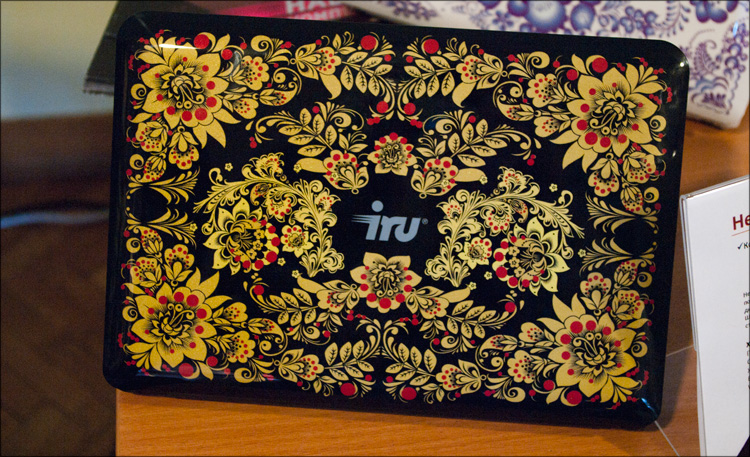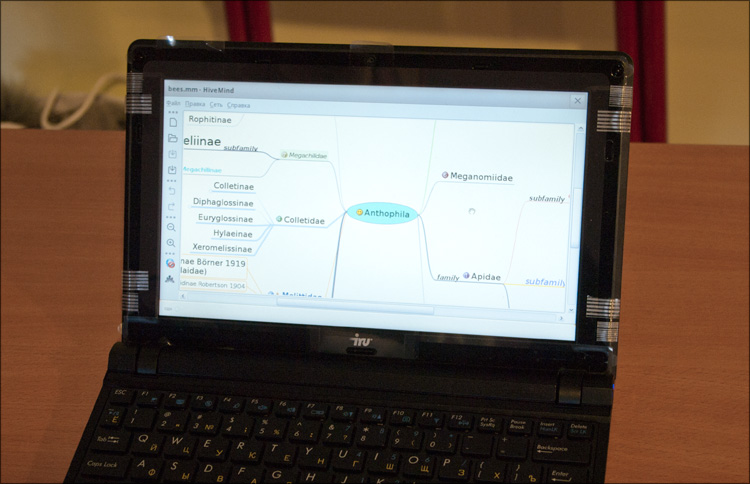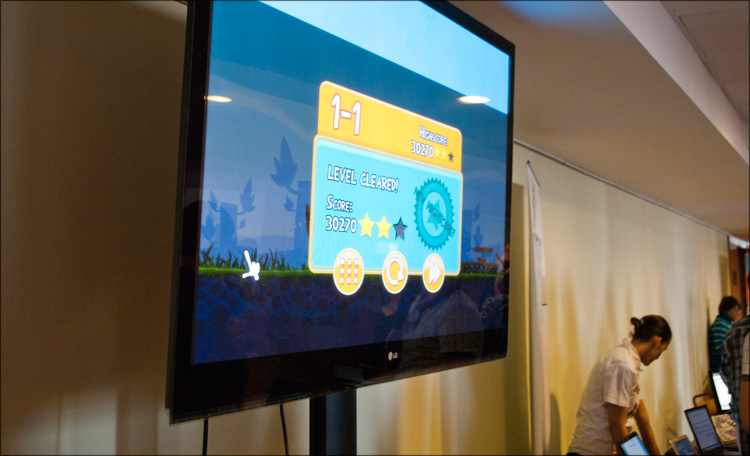Profit about MeeGo and robots
From March 9 to 11, a MeeGo 1 / Ru conference was held, hosted by the Fruct community with the support of Intel and Nokia. I was pleasantly surprised by the number of participants even on the third day of the event, although what is surprising is that at the World Mobile Congress the MeeGo stand was one of the most popular.

Probably, I will upset you, not having laid out in this post all the narrated information, but excuse me - I just couldn’t physically be able to attend the three-day event. I looked there for a very short time and only on the last day, at the awards ceremony for the winners of the developer competition (in the first two days there were trainings for developers).
')
1 place. Project “Glow”, Dmitry Ryzhkov .
A kind of graphics editor that uses the effect of neon glow. With it, you can create live, animated pictures - the interface is so simple that even a child can use the program.

2nd place. Project “HiveMind”, Andrey Vasilyev .
HiveMind is a linkage editor with co-editing features.

3rd place. The project “qMentro”, Leonid Gusak .
Metro map that supports the open format of maps PMZ - the format of the well-known program pMetro. The aim of the project is to create an analogue of pMetro, but with the support of a variety of platforms and languages.
The winners of the best MeeGo and Qt-application competitions were awarded to Kamil Isaev, General Director for Research and Development, Intel in Russia. I join congratulations - these are the people who were not lazy and were not afraid to take part in “another contest”, for which they were lucky)
After Kamil, other conference participants also spoke, for example, Pavel Frolov from the Linux Center. The most interesting part of his story seemed to me to be information about their own build of MeeGo 1.1 LinuxCenter Edition with many improvements over the standard version. Changes include an updated kernel version (2.6.37), full and correct Russification, support for NVIDIA Ion and NTFS, as well as various audio and video codecs; dopilennye drivers for Wi-Fi, 3G, 4G, integration with many social networks and services, and much more ... in general, who needs it - well. At the moment, this assembly is optimized for netbooks, but work on the tablet version is under way.
 ftp.linuxcenter.ru/pub/meego
ftp.linuxcenter.ru/pub/meego
But the most interesting part of any conference I have always considered is not theory, but practice — when I have something to look at. In the case of the MeeGo 1 / Ru conference, the “visual” part was the demo booth, which was attended by various partners - Lenovo , 3Q , iRu and DNS , as well as all those who began to practice the new operating system.


On some unbranded tablet, it was possible to live to feel the new interface of MeeGo, which was introduced at the last MWC. It works very fast, but it is still damp.

But most impressed by robots running the new operating system. More precisely, under the control of a laptop with MeeGo OS) A small machine on the remote control, working from the instructions of a small handkerchief (in the photo only an example of a circuit board, everything can fit in a much more compact body) - a modem for data transfer and the web are connected to it via USB camera to create spy shots. We ride, shoot, look at the world through the eyes of a toy car - can a bearded IT dad make a son a fun toy ?! )


But it turns out that it is possible not only to drive - during the conversation I noticed the mock-up of an airplane hanging right above us. That's right, it hangs for a reason - the authors' plans include the creation of unmanned devices operating on roughly the same equipment. As the developer of this project told me, there is no difficulty in creating a whole manageable network of such devices capable of operating in parallel.
Imagine if a group of climbers got lost somewhere in the mountains - instead of an expensive helicopter, you can send a couple of UAVs with cameras and communication modules that “comb” the terrain and transfer the data to the right place to find them. Well, or so, if you suddenly want to play spies ... the development of technologies like LTE here will be very useful.

Nearby was a less ambitious "toy" - a robot from LEGO, which was controlled via an ordinary joystick from a game console; Naturally, the receiver from this remote was in a laptop with MeeGo OS - it wasn’t just that it was locked in) The robot can go back and forth and turn, and one of the buttons was responsible for the work of some tentacles on board the pepelace.

That's probably all - taking a picture of myself in a troll shirt against the background of the event signboard, I left) All materials presented at the event should be on the Fruct.org website soon .

Probably, I will upset you, not having laid out in this post all the narrated information, but excuse me - I just couldn’t physically be able to attend the three-day event. I looked there for a very short time and only on the last day, at the awards ceremony for the winners of the developer competition (in the first two days there were trainings for developers).
')
1 place. Project “Glow”, Dmitry Ryzhkov .
A kind of graphics editor that uses the effect of neon glow. With it, you can create live, animated pictures - the interface is so simple that even a child can use the program.

2nd place. Project “HiveMind”, Andrey Vasilyev .
HiveMind is a linkage editor with co-editing features.

3rd place. The project “qMentro”, Leonid Gusak .
Metro map that supports the open format of maps PMZ - the format of the well-known program pMetro. The aim of the project is to create an analogue of pMetro, but with the support of a variety of platforms and languages.
The winners of the best MeeGo and Qt-application competitions were awarded to Kamil Isaev, General Director for Research and Development, Intel in Russia. I join congratulations - these are the people who were not lazy and were not afraid to take part in “another contest”, for which they were lucky)
After Kamil, other conference participants also spoke, for example, Pavel Frolov from the Linux Center. The most interesting part of his story seemed to me to be information about their own build of MeeGo 1.1 LinuxCenter Edition with many improvements over the standard version. Changes include an updated kernel version (2.6.37), full and correct Russification, support for NVIDIA Ion and NTFS, as well as various audio and video codecs; dopilennye drivers for Wi-Fi, 3G, 4G, integration with many social networks and services, and much more ... in general, who needs it - well. At the moment, this assembly is optimized for netbooks, but work on the tablet version is under way.
 ftp.linuxcenter.ru/pub/meego
ftp.linuxcenter.ru/pub/meegoBut the most interesting part of any conference I have always considered is not theory, but practice — when I have something to look at. In the case of the MeeGo 1 / Ru conference, the “visual” part was the demo booth, which was attended by various partners - Lenovo , 3Q , iRu and DNS , as well as all those who began to practice the new operating system.


On some unbranded tablet, it was possible to live to feel the new interface of MeeGo, which was introduced at the last MWC. It works very fast, but it is still damp.

But most impressed by robots running the new operating system. More precisely, under the control of a laptop with MeeGo OS) A small machine on the remote control, working from the instructions of a small handkerchief (in the photo only an example of a circuit board, everything can fit in a much more compact body) - a modem for data transfer and the web are connected to it via USB camera to create spy shots. We ride, shoot, look at the world through the eyes of a toy car - can a bearded IT dad make a son a fun toy ?! )


But it turns out that it is possible not only to drive - during the conversation I noticed the mock-up of an airplane hanging right above us. That's right, it hangs for a reason - the authors' plans include the creation of unmanned devices operating on roughly the same equipment. As the developer of this project told me, there is no difficulty in creating a whole manageable network of such devices capable of operating in parallel.
Imagine if a group of climbers got lost somewhere in the mountains - instead of an expensive helicopter, you can send a couple of UAVs with cameras and communication modules that “comb” the terrain and transfer the data to the right place to find them. Well, or so, if you suddenly want to play spies ... the development of technologies like LTE here will be very useful.

Nearby was a less ambitious "toy" - a robot from LEGO, which was controlled via an ordinary joystick from a game console; Naturally, the receiver from this remote was in a laptop with MeeGo OS - it wasn’t just that it was locked in) The robot can go back and forth and turn, and one of the buttons was responsible for the work of some tentacles on board the pepelace.

That's probably all - taking a picture of myself in a troll shirt against the background of the event signboard, I left) All materials presented at the event should be on the Fruct.org website soon .
Source: https://habr.com/ru/post/115432/
All Articles